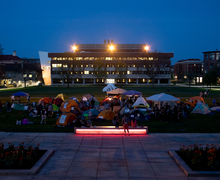Architecture students assist city in community development
Tucked away in the basement of Slocum Hall sits a room where aspiring architects try to recreate Syracuse.
Maps and blueprints cover the walls here, where Syracuse University architecture professor Elizabeth Kamell runs the Community Design Center, a program that joins the efforts of students and city workers to brainstorm a plan to redevelop a part of Syracuse each semester.
Surrounded by images of families strolling along a tree-lined Onondaga Creek and street artists performing in front of a giant mural, students are looking at the creek area for this year’s project, a district plagued by years of neglect.
‘They learn to understand urban design as a social and political condition,’ Kamell said. ‘It is a real opportunity to test their intellectual ability to apply the knowledge and experience they’ve gained in their classes.’
The city has completed two of the projects generated by the center, a Westside community park and a center at Wilson Park near the SU campus.
‘After that, the CDC gained momentum,’ Kamell said.
The center, which, in its fourth year, costs several thousand dollars to run each semester, receives funding from SU and the School of Architecture. But that money is only guaranteed through this year, Kamell said.
‘We don’t know what’s going to happen after the cut-off,’ she said.
Kamell said she also struggles each semester to solicit cooperation from other university programs. The CDC has worked in the past with departments including the Center for Public and Community Service and the School of Management.
Despite these setbacks, Kamell continues to find ways to give students the opportunity to learn about urban design, while simultaneously giving something to the community.
‘It’s an opportunity to improve the relationship between the city and the university,’ she said. ‘It’s important to understand what you do as an architect and as a designer had a real social and political impact.
‘The city in which they live is very much a part of their lives.’
Whether a financial crunch or a cement wall, Kamell uses these lessons to teach students the methods of urban design. The students must also deal with the political issues related with urban development, including the issue surrounding the development of Onondaga Creek, a key component to this project.
With the county finalizing its decision on where to put its sewage treatment plant, the creek area has taken center stage in the political arena.
‘The sewage treatment plant is going to determine how we develop this area,’ said Sam Gordon of the city’s Community Development office .
Some local activists do not think the area by the creek should be developed. But for businessmen in the area, developing the Westside may offer a last hope for their faltering district.
‘People will come if you’ve got something really good to offer,’ said Tim Wentworth, who owns an apartment complex in the area.
Instead of thriving stores and restaurants, the Westside now only offers crime and the crumbled remains of a once prosperous city, he said.
‘All of these things come when people stop investing in an area,’ he said.
Wentworth also serves as a member of the Westside group for the city’s Tomorrow’s Neighborhoods Today program, which promotes community development. He said those living in the Westside feel separated from the rest of their downtown neighbors.
‘We have been disconnected for a long time,’ he said. ‘We have been known as a gray area in the city of Syracuse. We’ve always been left out of everything.’
When the students complete their plan at the end of the semester, they will present the proposal to the city’s Community Development office, that can then use the plans to move forward on the project, said Gordon. The next step would be to hire a consultant to determine the cost efficiency of the plan. To fully complete the project would take about two years, he added.
‘There is a history of success with these projects,’ he said. ‘We have this resource of young, creative individuals that are learning by looking at a place and figuring out how to make this place make sense.’
And it was this real-life design experience that encouraged fourth-year architecture student Jacqueline Ho to sign up for the class.
Ho said the class differs from other architecture projects because rather than designing projects for a professor, students must consider the needs of the city.
‘Your desires kind of take a back seat,’ she said. ‘That’s what it’s all about.”
‘You take something that’s a difficult situation and you make the most of it. Sometimes, that’s where good design needs to come from.’
Published on October 23, 2002 at 12:00 pm




